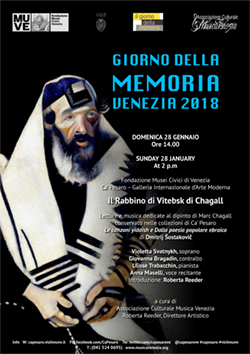
Recitation and music dedicated to
THE RABBI OF VITEBSK by MARK CHAGALL
in the collection of Ca’ Pesaro,
Galleria Internazionale d’Arte Moderna, Venice
Yiddish Songs and From Jewish Folk Poetry
by Dmitry Shostakovich
Violetta Svatnykh soprano
Giovanna Bragadin contralto
Ulisse Trabacchin piano
Roberta Reeder introduction
Anna Maselli narrator
CA' PESARO
Sunday 28 January 2018 at 2 p.m.
Info: (+39) 041 524 0695
Admission Free
Seats available until all occupied
As every year, the Associazione Culturale Musica Venezia is participating in Remembrance Day, the commemoration of the Holocaust, and is presenting a recitation and music dedicated to the work by Marc Chagall, “The Rabbi of Vitebsk,” which belongs to the collection of Ca’ Pesero.
The musical portion will be in two parts:
Yiddish Songs: This part includes two songs which focus on the figure of the rabbi: when he teaches boys the Hebrew alphabet, and when he sings and dances, typical of the Hasidic rabbi, followed by songs from the religious ritual Chanukah, songs of everyday life, and songs of the Holocaust.
“From Jewish Folk Poetry” by Dmitry Shostakovich: Shostakovich composed this work in 1948. The composer himself tells how he was inspired to write this cycle. “In a book shop one day after the war, I found a volume of Jewish songs; I have always been interested in Jewish folklore. However, the book only contained the texts. I thought I would choose some and set them to music, and in this way I would be able to illustrate the destiny of the Jewish people I thought this was very important because all around me I saw anti-semitism increasing.” Shostakovich wrote the music to this cycle under the influence of the Yiddish musical tradition.
Vitebsk e Chagall
Vitebsk is a town (shtetl) in Byelorussia where Chagall was born in 1887 to a Jewish Hasidic family, and he suffered under the difficult conditions typical of most of the Jews in Imperial Russia at this time. In the shtetl the Jews were considered foreigners in a society which was hostile to them. They were not only subject to discrimination, but also to the pogroms, massacres in which they were slaughtered and their houses plundered and burned. In 1910 Chagall went to Paris, returned to Russia in 1914, but then in 1923 moved to Paris, where he spent most of the rest of his life. However, in his works, Chagall always returned to the “Vitebsk period,” with the same motifs: wooden houses, a rooster, a cow, a young couple floating in the air, a fiddler on the roof, and a rabbi, as testified in the very beautiful work, “The Rabbi of Vitebsk,” in the Ca’ Pesaro collection.
The event will take place at Ca’ Pesaro, international Gallery of Modern Art, Sunday, 28 January at 2 p.m.
For information: tel. 041 524 0695. Admission free. Seats available until all occupied.

